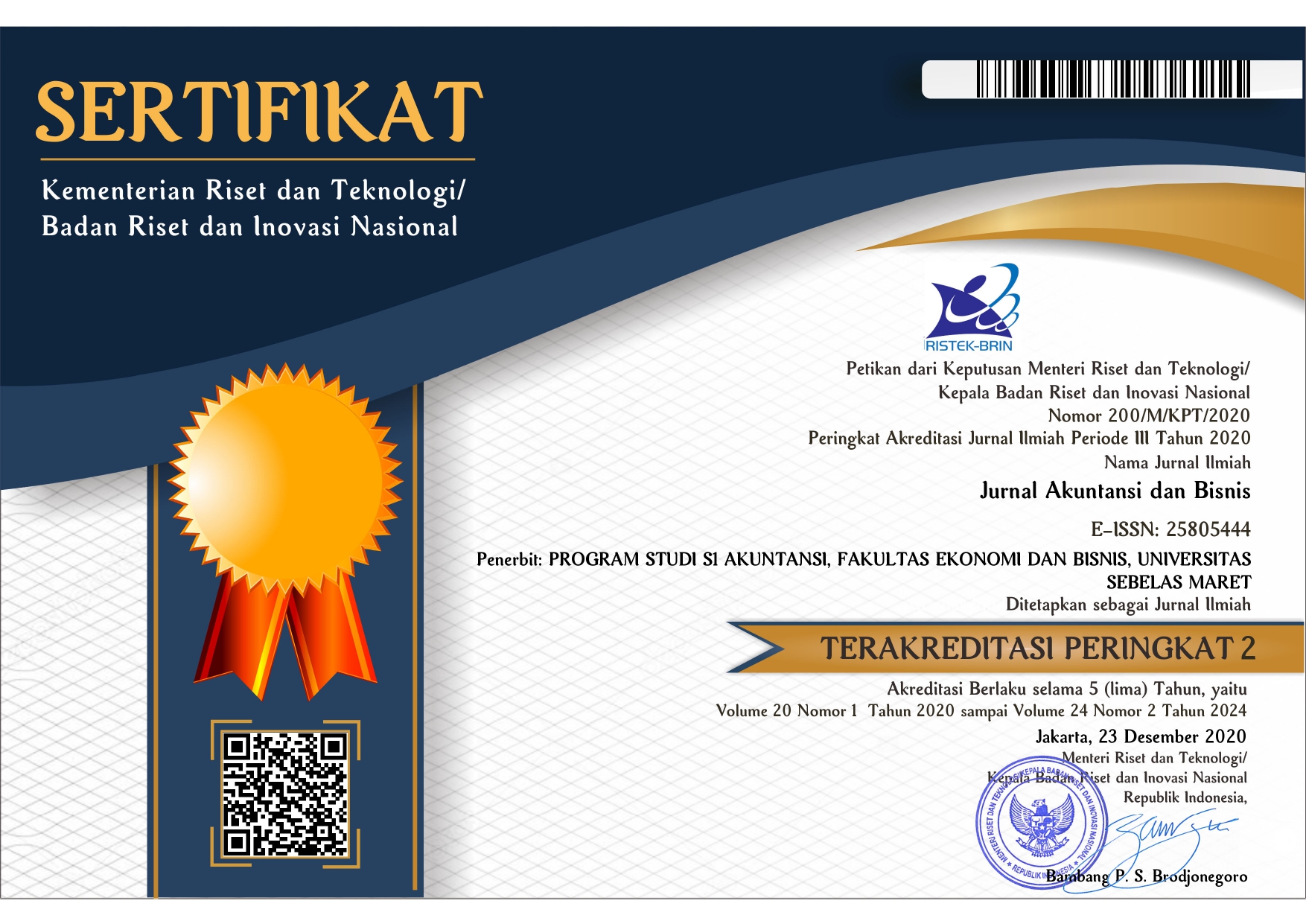Peran Income Smoothing dalam Meningkatkan Earnings Informativeness
Abstract
The samples in the study were determined by using purposive sampling, which took samples of non-financial companies, with years of observation from 2004 to 2011. The research sample includes 104 non-financial companies listed on the Indonesia Stock Exchange. This study using SPSS 20 version, as multiple regression analysis (multiple regression). Tests conducted on the interaction effect of income smoothing with future earnings to return.
The test results in this study showed a significant positive value, indicated that income smoothing action able to strengthening the relationship of earnings and return. This proves that income smoothing action is not always biased (garbles), but this action is aimed as efficient communication, because the information generated by company is significantly can be used as a prediction of future information. These results are consistent with Zarowin (2002), Tucker and Zarowin (2006), Cahan et al., (2008), as well as Hamzawi and Alfatooni (2011).
References
Agustiningsih, Sri Wahyu. 2009. Pengaruh Income Smoothing Terhadap Keinformatifan Laba.Tesis. Universitas Sebelas Maret. Surakarta
Ball, Ray dan Philip Brown. 1968. An Empirical Evaluation of Accounting Income Number. Journal of Accounting Research.Vol 6.p.159-178.
Beaver, W, R, dan W. Wright. 1979. The Association Between Unsystematic Security Returns and The Magnitude of Earning Forecast Errors. Journal of Accounting Research, No. 17.
Beneish, M.D. dan D.C. Nichols. 2005. Earnings Quality and Future Returns: The Relation between Accruals and The Probability of Earnings Manipulation. Available :http://www.ssrn.com
Cahan, Steven F., Guopong Liu dan Jerry Sun. 2008. Investor Protection, Income Smoothing dan Earnings Informativeness. Journal of International Accounting Research Vol. 7, p. 1-24.
Collins, D. W., S. P. Kothari, J. Shanken, dan R. Sloan. 1994. Lack of timeliness and noise as explanations for the low contemporaneous return-earnings association. Journal of Accounting and Economics, Vol. 18, p. 289–324.
Daske, Holger, Luzi Hail, Christian Leuz, dan Rodrigo Verdi. 2008. Mandatory IFRS Reporting Around the World: Early Evidence on the Economic Consequences. Working Paper No. 12.
DeFond, M., dan C.W. Park.1997. Smoothing Income in Anticipation of Future Earnings.Journal of Accounting and Economics, Vol. 23, p.115-140.
Durnev, Artyom, Randall Morck, Bernard Yeung dan Paul Zarowin. 2003. Does Greater Firm-Specific Return Variation Mean More or Less Informed Stock Pricing?.Journal of Accounting Research Vol. 41 No. 5 December. 797-836.
Dye, R.A. 1988. Earning Management in an Overlapping Generations Model, Journal Accounting Research, Vol. 26, p. 195-235
Ettredge, Michael L., Soo Young Kwon, David B. Smith, dan Paul A. Zarowin. 2005. The Impact of SFAS No. 131 Business Segment Data on the Market’s Ability to Anticipate Future Earnings.The Accounting Review.Vol. 80, No. 3. pp. 773–804
Fama, Eugene F., 1990, Stock Returns, Expected Returns and Real Activity, Journal of Finance 45, 1089-l 108.
Gelb, David dan Paul Zarowin, 2002.Corporate Disclosure Policy and the Informativeness of Stock Prices.Available, http://www.ssrn.com
Ghozali, Imam, 2007. Aplikasi Analisis Multivariate Dengan Program SPSS. Badan Penerbit Universitas Diponegoro.
Grant, J., G. Markarian,dan A. Parbonett, 2009, CEO Risk-Related Incentives and Income Smoothing. Contemporary Accounting Research 26, p. 1029-1065
Hamzavi, Mohammad A. dan Abbas Aflatooni. 2011. Earnings Smoothing and Earnings Predictability. Business Intelligence Journal.January Vol.4 No.1.
Healy, Paul M. 1985. The Effect of Bonus Schemes on Accounting Decisions.Journal of Accounting and Economics, Vol. 7, p. 85-107.
Holthausen, R. W., Larke, K. M., dan Sloan, R. G. 1995. Annual Bonus Schemes and The Manipulation Earnings. Journal of Accounting and Economics, Vol. 12, p. 29-74
Hunt, Alister, Moyer, Susan E, Shevlin, Terry,. 2000. Earnings Volatility, Earning Management, and Equity Value. Available :http://www.ssrn.com.
Jayaraman, S. 2008. Earnings Volatility, Cash Flow Volatility, and Informed Trading .Journal of Accounting Research ,Vol. 46, p. 809-851
Jensen, Michael, dan William Meckling, 1976. Theory of TheFirm: Managerial Behavior, Agency Cost, and Ownership Structure, Journal of Financial Economics, Vol. 3, p. 305-360.
Jogiyanto H.M. Teori Portofolio dan Analisis Investasi, edisi ke-2, Yogyakarta: BPFE,2000
Kirschenhiter, dan N.D. Melumad. 2007. Earnings Quality and Smoothing. Working Paper.University of Illinois at Chicago and Columbia University.
Lipe, Robert. 1990. The Relation Between Stock Returns and Accounting Earnings Given Alternative Information. The Accounting Review.Vol. 65. No. 1 Januari, pp. 49-71
Lundholm, R., and L. Myers. 2002. Bringing the Future Forward: The Effect of Disclosure on The Returns-Earnings Relation. Journal of Accounting Research, Vol.40, p. 809–839.
Orpurt, Steven F. dan Yoonseok Zang. 2009. Do Direct Cash Flow Disclosures Help Predict Future Operating Cash Flows and Earnings?.The Accounting Review, Vol. 84, No. 3, 2009. pp. 893–935.
Oswald, Dennis R. dan Paul Zarowin.2007.European Accounting Review. Vol. 16, No. 4, 703–726
Penman, S.H. dan X.J. Zhang. 2002. Accounting Conservatism, the Quality of Earnings, and Stock Return. The Accounting Review 77, p. 237 – 264
Ronen, J., dan Sadan, S. 1981. Smoothing Income Numbers: Objectives, Means, and Implications. Boston, MA: Addison-Wesley Publishing Company.
Ross, Stephen A. 1977. The Determination of Financial Structure: the Incentive Signalling Approach. The Bell Journal of Economics, Vol. 8, No. 1. p. 23-40.
Shankar, M. dan Subramanyam, K.R. 2001. Reporting Discretion and Privat Information Communication Through Earnings. Journal of Accounting Research , Vol. 39,p . 365–386.
Sharpe, William E,Alexander, Gordon J., dan Bailey, Jeffrey V. 1995. Investment, 5th John Wiley & Sons, Inc. New Jersey.
Subramanyam, K.R. 1996. The Pricing of Discretionary Accruals.Journal of Accounting and Economics, Vol. 22, p. 249-281
Sutopo, B. 2007.Manajemen Laba dan Manfaat Kualitas Laba dalam Keputusan Investasi. Pidato yang disampaikan dalam Pengukuhan Guru Besar Bidang Akuntansi pada Fakultas Ekonomi Universitas Sebelas Maret. Surakarta.
Tucker, Jennifer W., dan Zarowin, Paul A. 2006. Does Income Smoothing Improve Earning Informativeness?.The Accounting Review, Vol. 81, p. 251-270.
Watts, R., dan J. Zimmerman. 1986. Positive Accounting Theory. Prentice Hall Inc., Englewood Cliffs, NJ.
Zarowin, Paul. 2002. Does Income Smoothing Make Stock Prices More Informative?.Available :http://www.ssrn.com.
DOI: http://dx.doi.org/10.20961/jab.v14i2.159
Jurnal Akuntansi dan Bisnis (JAB)
ISSN 1412-0852 (print), 2580-5444 (online)
Published by Accounting Study Program, Faculty of Economics and Business, Universitas Sebelas Maret, Indonesia

JAB on http://jab.fe.uns.ac.id/index.php/jab is licensed under a Creative Commons Attribution-ShareAlike 4.0 International License










